Numerical Simulations to Predict the Seismic Performance of a 2-Story Steel Moment-Resisting Frame
Abstract
1. Introduction
2. The Investigated Structure
3. Numerical Models
3.1. Modeling Assumptions
3.2. Simulation of the Hysteretic Response of the Joints
4. Numerical Prediction of the Seismic Performance of the Investigated Structure
4.1. Pushover Analyses
4.2. Incremental Dynamic Analyses
5. Conclusions
- FE simulations confirm that the non-linear performance of the examined joints is consistent with their relevant design assumptions.
- The adoption of concentrated plastic hinges (CPH) allows concentrating the plastic response of the joint in a lumped spring, while all other elements can be modeled as elastic elements. However, it should be noted that for the plastic hinge at the column base, the presence of vertical forces should be taken into account a-priori to properly calibrate the spring response.
- The smooth multilinear model was used to simulate the hysteretic behavior of CPH and it showed satisfactory agreement with the results obtained from FE simulations. Due to their versatility, this type of model can be easily used to mimic the joint non-linear behavior in both static and dynamic analyses.
- Distributed plasticity (DP) models allow to directly account for the bending-axial force interaction in the column. However, in case of static non-linear analyses, the DP model does not allow to account for the strength degradation. Contrariwise, both in cyclic static and dynamic analyses, the hinge strength degradation can be accounted for by the calibration of the cyclic degradation of the material model.
- The results from IDAs plotted in terms of maxima base shear and corresponding horizontal displacements are in line with the results of the pushover curves, showing almost the same lateral capacity and comparable elastic stiffness.
- Independently from the type of joints (i.e., H or RBS) and how they are modeled (i.e., CPH or DP), the investigated structures remain in elastic range up to the significant damage limit state. In addition, only when subjected to the Northridge earthquake, large plastic capacity (i.e., 4%) is required to the joints.
- The modeling approach plays a key role only at large value of imposed rotation, while no appreciable differences can be pointed out in elastic range, where CPH and DP provide almost the same results.
- The measured residual drift ratios are generally negligible (smaller than 0.5%) independently from the type of adopted joint (i.e., haunched or RBS); thus, only when the frame is subjected to severe plastic demand (i.e., in case of Northridge earthquake) residual drift ratios larger the 1% were measured.
- The study summarized in this paper represents the preliminary work to design the experimental campaign within the “FUTURE” project. Further research will be carried out to extend the numerical activity with parametric analyses to investigate the sensitivity of different modeling approaches on different geometrical and mechanical parameters such as the number of span, the number of storys, the interstory height, etc.
Author Contributions
Funding
Conflicts of Interest
References
- Brunesi, E.; Nascimbene, R.; Rassati, G.A. Seismic response of MRFs with partially restrained bolted beam-to-column connections through FE analyses. J. Constr. Steel Res. 2015, 107, 37–49. [Google Scholar] [CrossRef]
- Elghazouli, A.Y. Assessment of European seismic design procedures for steel framed structures. Bull. Earthq. Eng. 2010, 8, 65–89. [Google Scholar] [CrossRef]
- Elghazouli, A.Y.; Castro, J.M.; Izzuddin, B. Seismic performance of composite moment resisting frames. Eng. Struct. 2008, 30, 1802–1819. [Google Scholar] [CrossRef]
- Montuori, R.; Nastri, E.; Piluso, V.; Troisi, M. Influence of the cyclic behaviour of beam-to-column connection on the seismic response of regular steel frames. Ing. Sismica 2016, 33, 91–105. [Google Scholar]
- Montuori, R.; Nastri, E.; Piluso, V.; Troisi, M. Influence of connection typology on seismic response of MR-Frames with and without ‘set-backs’. Earthq. Eng. Struct. Dyn. 2017, 46, 5–25. [Google Scholar] [CrossRef]
- Giordano, V.; Chisari, C.; Rizzano, G.; Latour, M. Prediction of seismic response of moment resistant steel frames using different hysteretic models for dissipative zones. Ing. Sismica 2017, 34, 42–56. [Google Scholar]
- Ramhormozian, S.; Clifton, G.C.; Latour, M.; MacRae, G.A. Proposed simplified approach for the seismic analysis of multi-storey moment resisting framed buildings incorporating friction sliders. Buildings 2019, 9, 130. [Google Scholar] [CrossRef]
- Iannone, F.; Latour, M.; Piluso, V.; Rizzano, G. Experimental analysis of bolted steel beam-to-column connections: Component identification. J. Earthq. Eng. 2011, 15, 214–244. [Google Scholar] [CrossRef]
- Di Benedetto, S.; Francavilla, A.B.; Latour, M.; Piluso, V.; Rizzano, G. Pseudo-dynamic testing of a full-scale two-storey steel building with RBS connections. Eng. Struct. 2019, 212, 110494. [Google Scholar] [CrossRef]
- Costanzo, S.; Tartaglia, R.; Di Lorenzo, G.; De Martino, A. Seismic Behaviour of EC8-Compliant Moment Resisting and Concentrically Braced Frame. Buildings 2019, 9, 196. [Google Scholar] [CrossRef]
- Malekpour, S.; Seyyedi, P.; Dashti, F.; Asghari, J.F. Seismic performance evaluation of steel moment-resisting frames using Iranian, European and Japanese seismic codes. Procedia Eng. 2011, 14, 3331–3337. [Google Scholar] [CrossRef]
- Tremblay, R.; Filiatrault, A. Seismic performance of steel moment resisting frames retrofitted with a locally reduced beam section connection. Can. J. Civ. Eng. 1997, 24, 78–89. [Google Scholar] [CrossRef]
- Dalal, S.P.; Vasanwala, S.A.; Desai, A.K. The performance evaluation of ordinary moment resisting frames designed by performance-based plastic design and limit state design. Int. J. Struct. Eng. 2015, 6, 195–211. [Google Scholar] [CrossRef]
- European Committee for Standardization. EN 1993:1–8, Design of Steel Structures—Part 1–8: Design of Joints; CEN: Brussels, Belgium, 2005. [Google Scholar]
- European Committee for Standardization. EN 1998-1, Design of Structures for Earthquake Resistance—Part 1: General Rules, Seismic Actions and Rules for Buildings; CEN: Brussels, Belgium, 2005. [Google Scholar]
- Francavilla, A.B.; Latour, M.; Piluso, V.; Rizzano, G. Design of full-strength full-ductility extended end-plate beam-to-column joints. J. Constr. Steel Res. 2018, 148, 77–96. [Google Scholar] [CrossRef]
- Francavilla, A.B.; Latour, M.; Piluso, V.; Rizzano, G. Design criteria for beam-to-column connections equipped with friction devices. J. Constr. Steel Res. 2020, 172, 106240. [Google Scholar] [CrossRef]
- Cavallaro, G.F.; Francavilla, A.B.; Latour, M.; Piluso, V.; Rizzano, G. Cyclic response of low yielding connections using different friction materials. Soil Dyn. Earthq. Eng. 2018, 114, 404–423. [Google Scholar] [CrossRef]
- Lemos, A.; da Silva, L.S.; Latour, M.; Rizzano, G. Numerical modelling of innovative DST steel joint under cyclic loading. Arch. Civ. Mech. Eng. 2018, 18, 687–701. [Google Scholar] [CrossRef]
- Latour, M.; Rizzano, G. Experimental behavior and mechanical modeling of dissipative T-stub connections. J. Struct. Eng. 2012, 138, 170–182. [Google Scholar] [CrossRef]
- American Institute of Steel Construction (AISC)Prequalified Connections for Special and Intermediate Steel Moment Frames for Seismic Applications; ANSI/AISC 358-16; American Institute of Steel Construction: Chicago, IL, USA, 2016.
- Building Standard Law of Japan (BSL), Provided by The Building Center of Japan (BCJ). Available online: http://www.bcj.or.jp. (accessed on 28 October 2020).
- Landolfo, R. European Pre-QUALified Steel JOINTS—EQUALJOINTS: Final Report—European Commission Research Programme of the Research Fund for Coal and Steel, Technical Group: TG S8; European Commission: Brussels, Belgium, 2017; EUR 28903; ISSN 1831-9424. [Google Scholar]
- Landolfo, R. EQUALJOINTS-Plus: Final Report—European Commission Research Programme of the Research Fund for Coal and Steel, Technical Group: TG S8; European Commission: Brussels, Belgium, 2019. [Google Scholar]
- Goltz, J.D. The Northridge, California Earthquake of January 17, 1994: General Reconnaissance Report; Report No. NCEER-94-0005; National Centre for Earthquake Engineering Research: Buffalo, NY, USA, 1994. [Google Scholar]
- Youssef, N.F.G.; Bonowitz, D.; Gross, J.L. A Survey of Steel Moment-Resisting Frame Buildings Affected by the 1994 Northridge Earthquake; Report No. NISTR 56254; National Institute for Science and Technology: Gaithersburg, MD, USA, 1995. [Google Scholar]
- Watanabe, E.; Sugiura, K.; Nagata, K.; Kitane, Y. Performances and damages to steel structures during 1995 Hyogoken–Nanbu earthquake. Eng. Struct. 1998, 20, 282–290. [Google Scholar] [CrossRef]
- Di Sarno, L.; Elnashai, A.S.; Manfredi, G. Assessment of RC columns subjected to horizontal and vertical ground motions recorded during the 2009 L’Aquila (Italy) earthquake. Eng. Struct. 2011, 33, 1514–1535. [Google Scholar] [CrossRef]
- Landolfo, R. Study of the Seismic Behavior of Knauf Partition and Façade Walls Based on the Critical Analysis of Available Experimental Tests, Final Report; European Comission: Bruxelles, Belgium, 2013. [Google Scholar]
- Landolfo, R.; Pali, T.; Bucciero, B.; Terracciano, M.T.; Shakeel, S.; Macillo, V.; Iuorio, O.; Fiorino, L. Seismic response assessment of architectural non-structural LWS drywall components through experimental tests. J. Constr. Steel Res. 2019, 162, 105575. [Google Scholar]
- Pali, T.; Macillo, V.; Terracciano, M.T.; Bucciero, B.; Fiorino, L.; Landolfo, R. In-plane quasi-static cyclic tests of nonstructural lightweight steel drywall partitions for seismic performance evaluation. Earthq. Eng. Struct. D 2018, 47, 1566–1588. [Google Scholar] [CrossRef]
- Tartaglia, R.; D’Aniello, M.; Di Lorenzo, G.; De Martino, A. Influence of EC8 rules on p-delta effects on the design and response of steel MRF. Ing. Sismica 2018, 35, 104–120. [Google Scholar]
- Di Lorenzo, G.; Formisano, A.; Landolfo, R. On the origin of I beams and quick analysis on the structural efficiency of hot-rolled steel members. Open Civ. Eng. J. 2017, 11, 332–344. [Google Scholar] [CrossRef]
- Di Lorenzo, G.; Babilio, E.; Formisano, A.; Landolfo, R. Innovative steel 3D trusses for preservating archaeological sites: Design and preliminary results. J. Constr. Steel Res. 2019, 154, 250–262. [Google Scholar] [CrossRef]
- Rizzo, F.; Di Lorenzo, G.; Formisano, A.; Landolfo, R. Time-Dependent Corrosion Wastage Model for Wrought Iron Structures. J. Mater. Civ. 2019, 31, 4019165. [Google Scholar] [CrossRef]
- Dassault. Abaqus 6.14—Abaqus Analysis User’s Manual, Dassault Systèmes Simulia Corp; Dassault: Velizy-Villacoublay, France, 2014. [Google Scholar]
- SeismoStruct 2020—A Computer Program for Static and Dynamic Nonlinear Analysis of Framed Structures. Available online: http://www.seismosoft.com (accessed on 28 October 2020).
- Tartaglia, R.; D’Aniello, M.; Zimbru, M.; Landolfo, R. Finite element simulations on the ultimate response of extended stiffened end-plate joints. Steel Compos. Struct. 2018, 827, 727–745. [Google Scholar]
- Tartaglia, R.; D’Aniello, M.; Zimbru, M. Experimental and numerical study on the T-Stub behaviour with preloaded bolts under large deformations. Structures 2020, 27, 2137–2155. [Google Scholar] [CrossRef]
- American Institute of Steel Construction (AISC). Seismic Provisions for Structural Steel Buildings; ANSI/AISC 341-16; AISC: Chicago, IL, USA, 2016. [Google Scholar]
- Chopra, A.K.; McKenna, F. Modeling viscous damping in nonlinear response history analysis of buildings for earthquake excitation. Earthq. Eng. Struct. D 2016, 45, 193–211. [Google Scholar] [CrossRef]
- Bosco, M.; Tirca, L. Numerical simulation of steel I-shaped beams using a fiber-based damage accumulation model. J. Constr. Steel Res. 2017, 133, 241–255. [Google Scholar] [CrossRef]
- Lignos, D.G.; Hartloper, A.R. Steel column stability and implications in the seismic assessment of steel structures according to Eurocode 8 Part 3. Stahlbau 2020, 89, 16–27. [Google Scholar] [CrossRef]
- Panyakapo, P. Cyclic pushover analysis procedure to estimate seismic demands for buildings. Eng. Struct. 2014, 66, 10–23. [Google Scholar] [CrossRef]
- Barbagallo, F.; Bosco, M.; Ghersi, A.; Marino, E.M.; Rossi, P.P. Seismic Assessment of Steel MRFs by Cyclic Pushover Analysis. Open Constr. Build. Technol. J. 2019, 13, 12–26. [Google Scholar] [CrossRef]
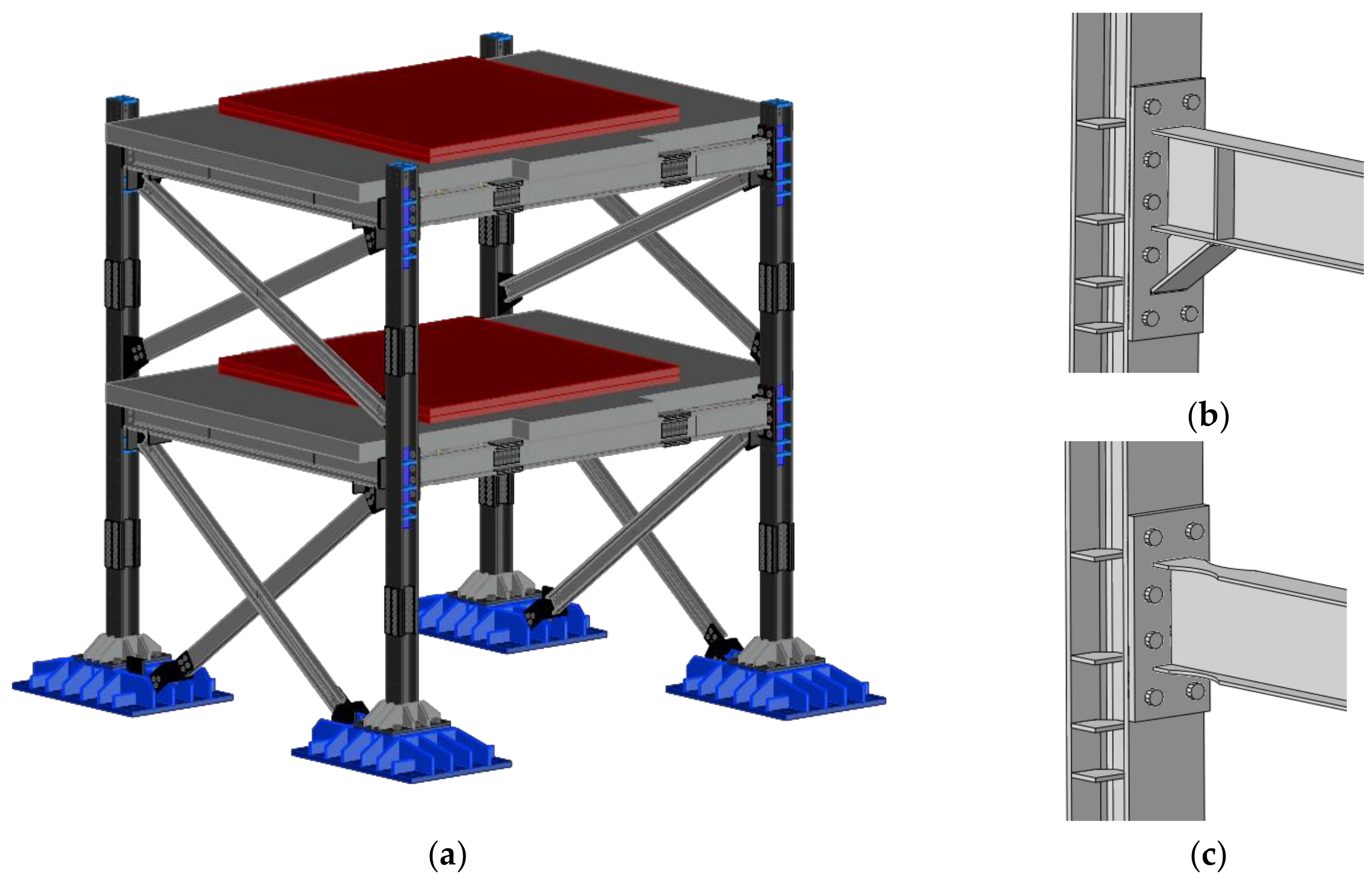
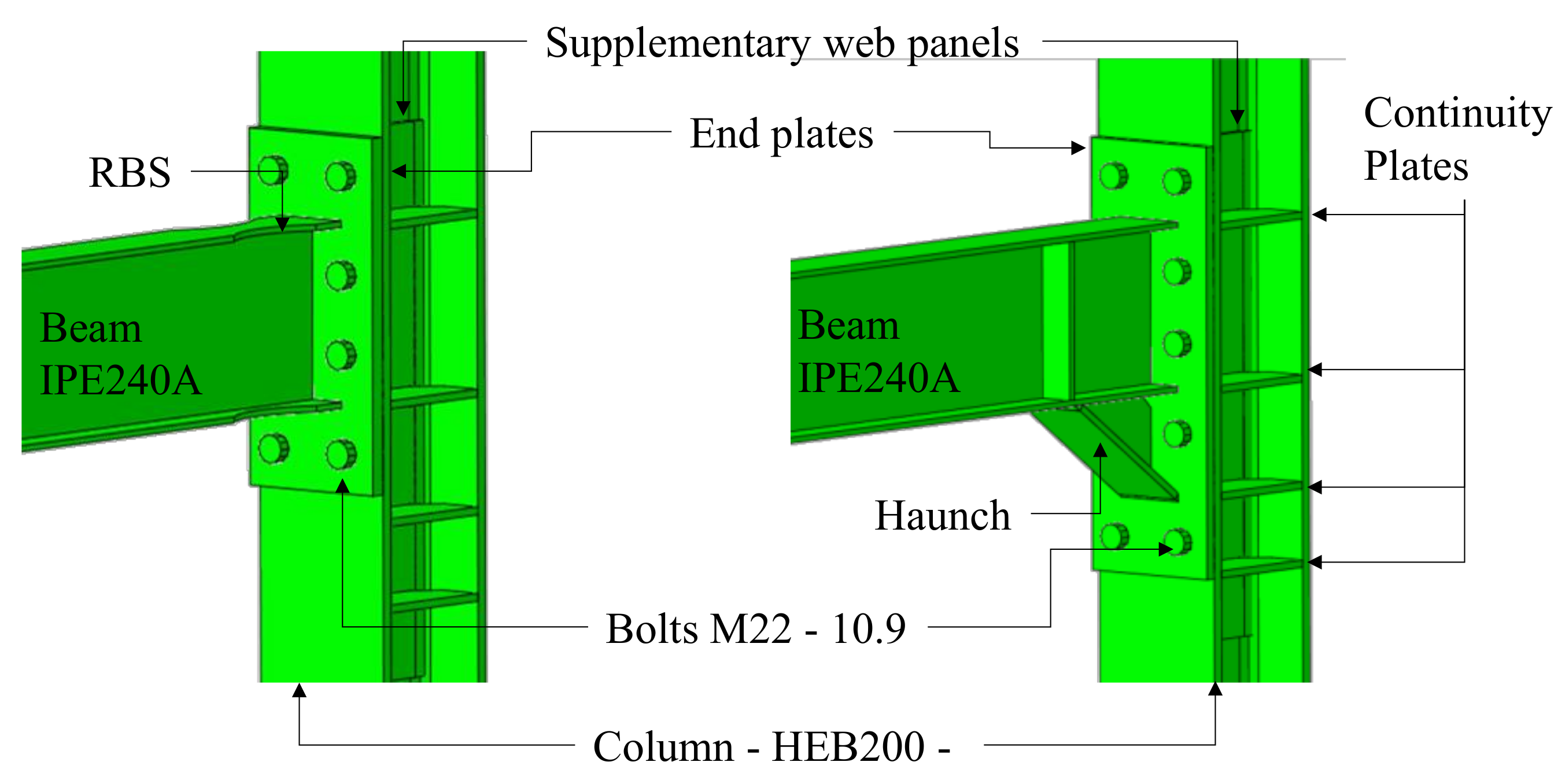
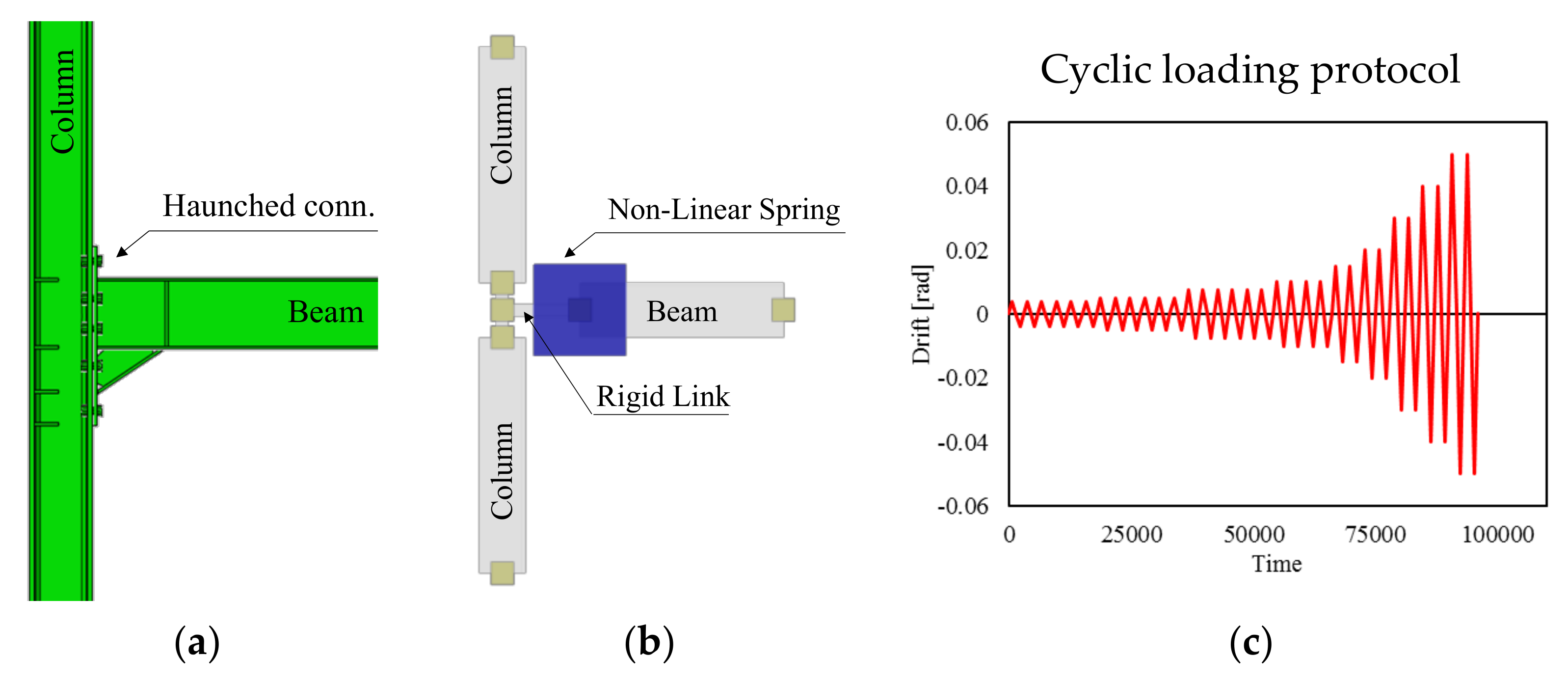
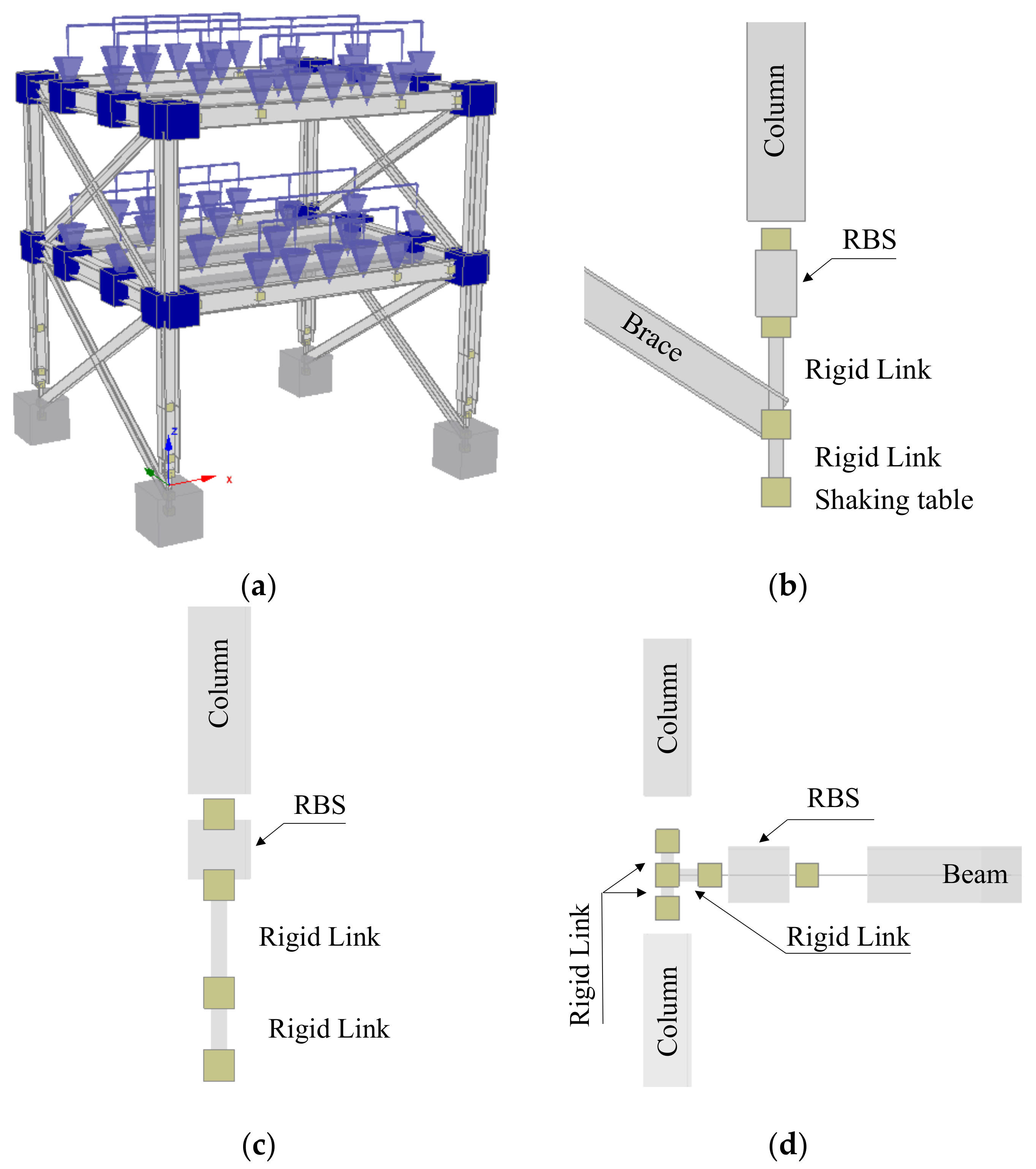



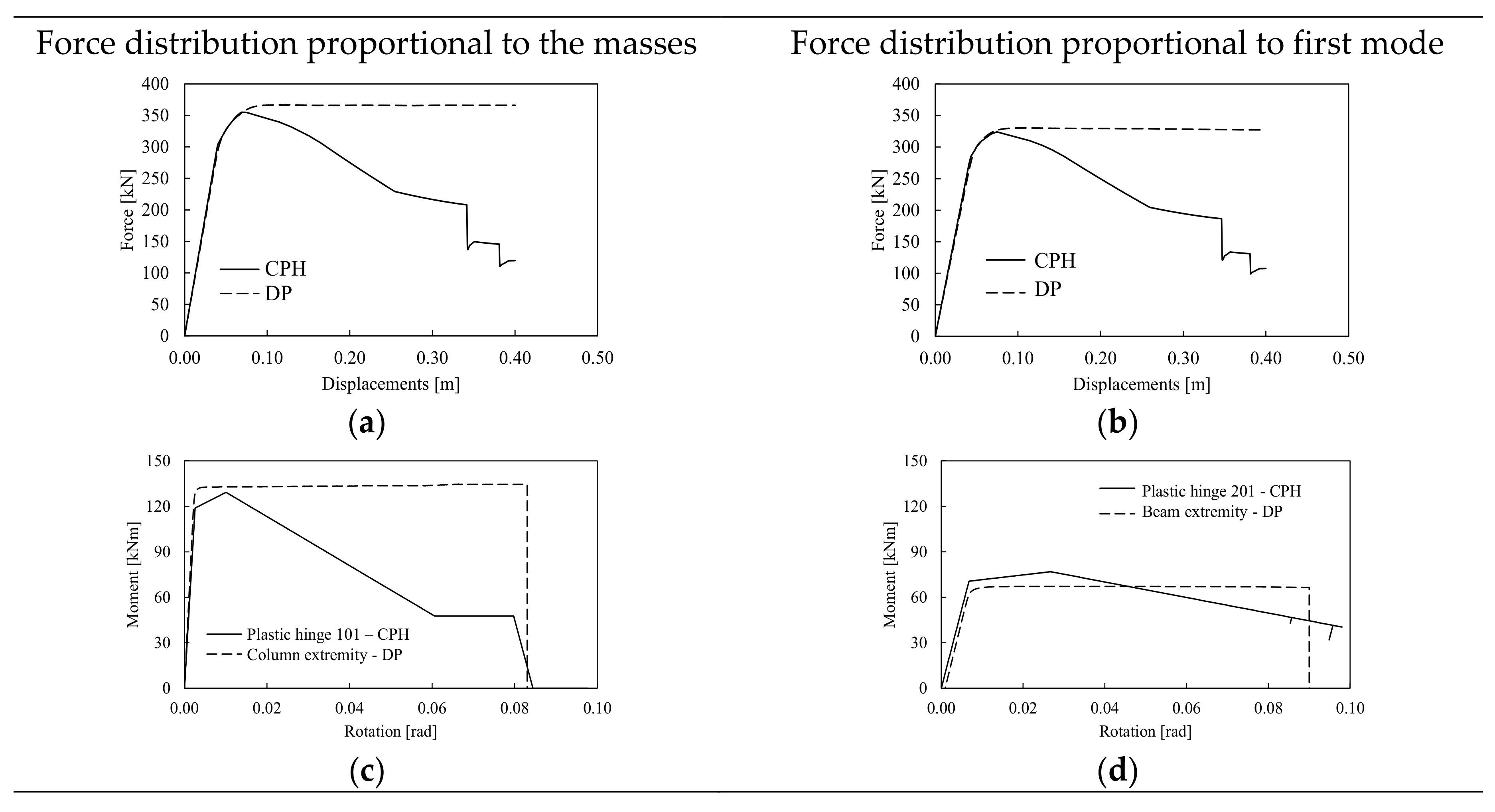


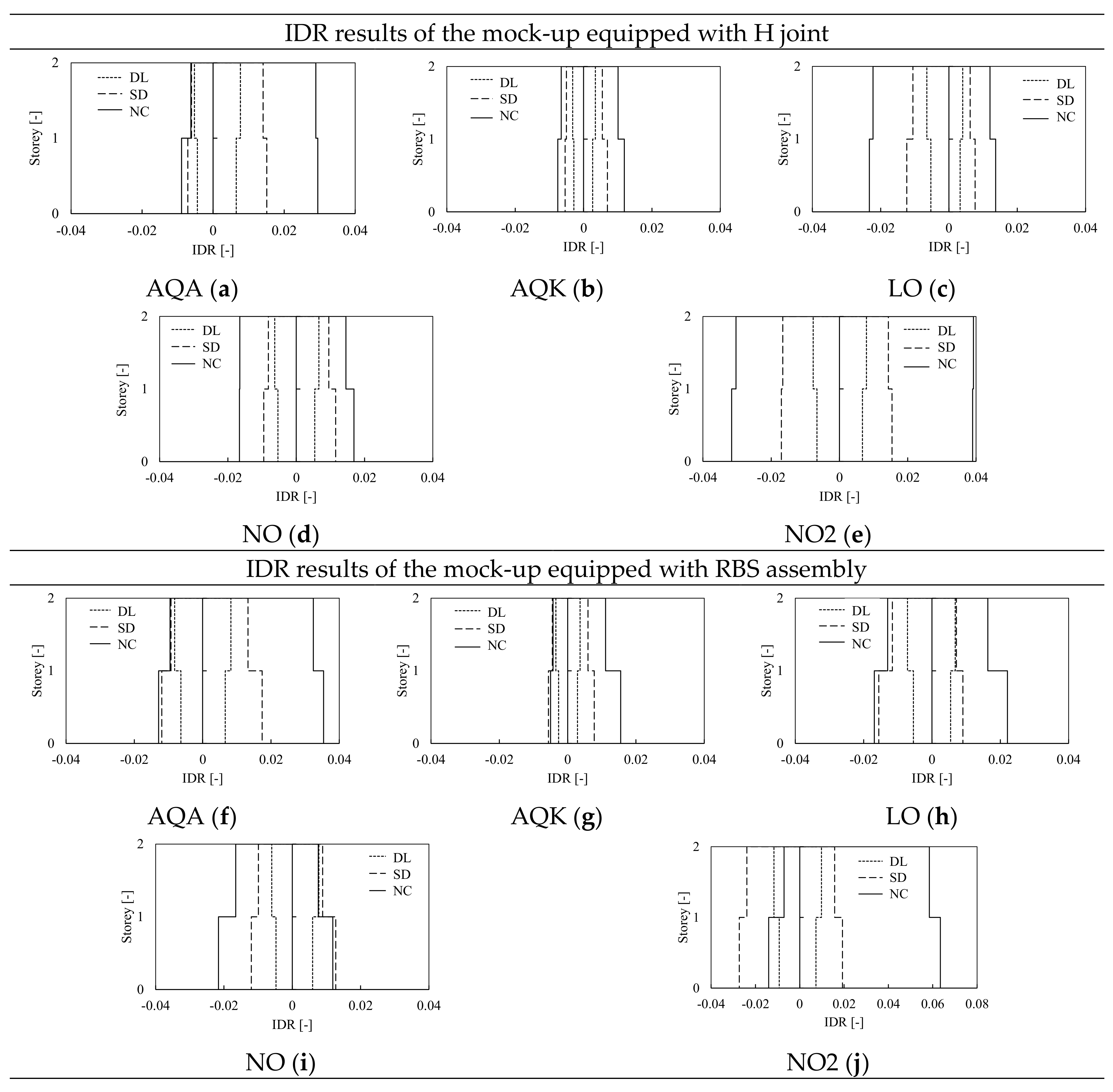
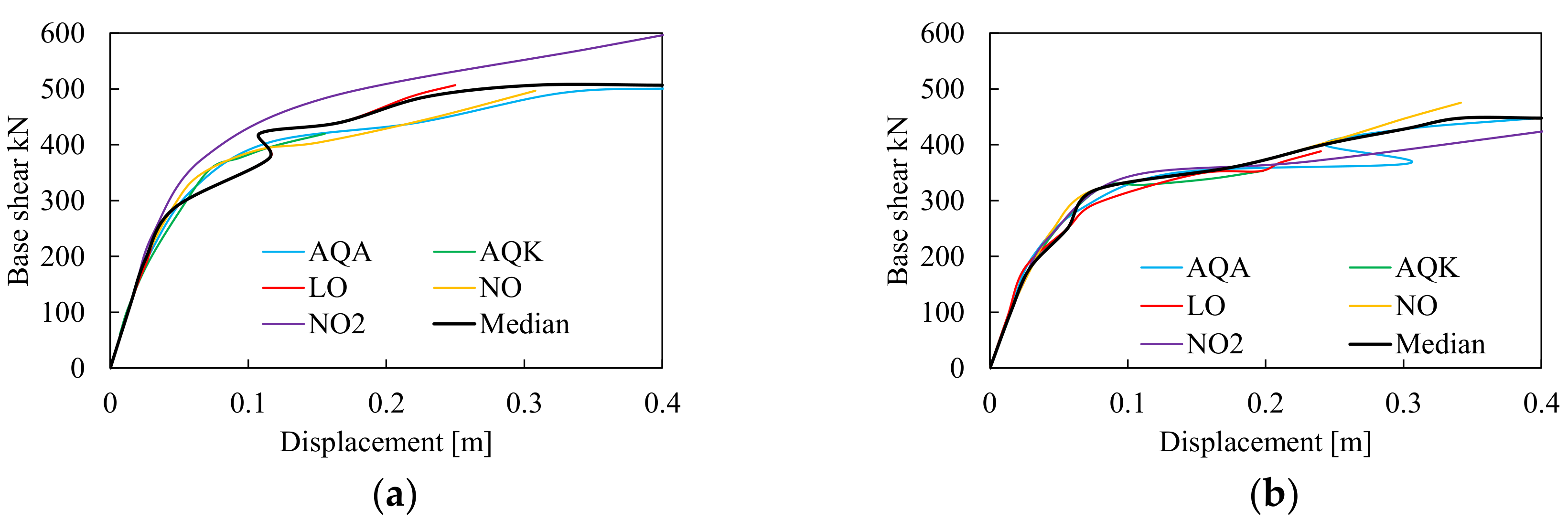
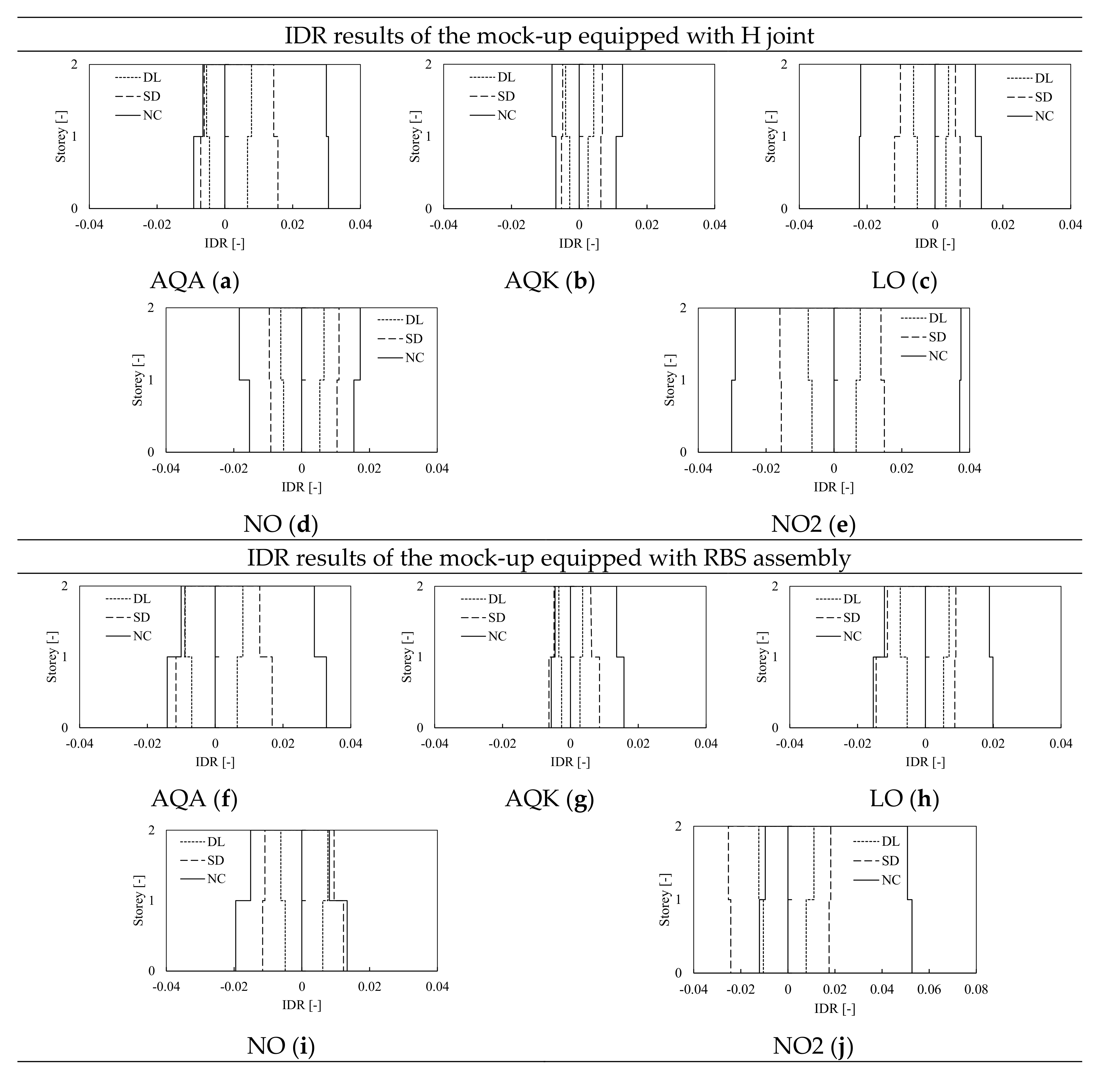
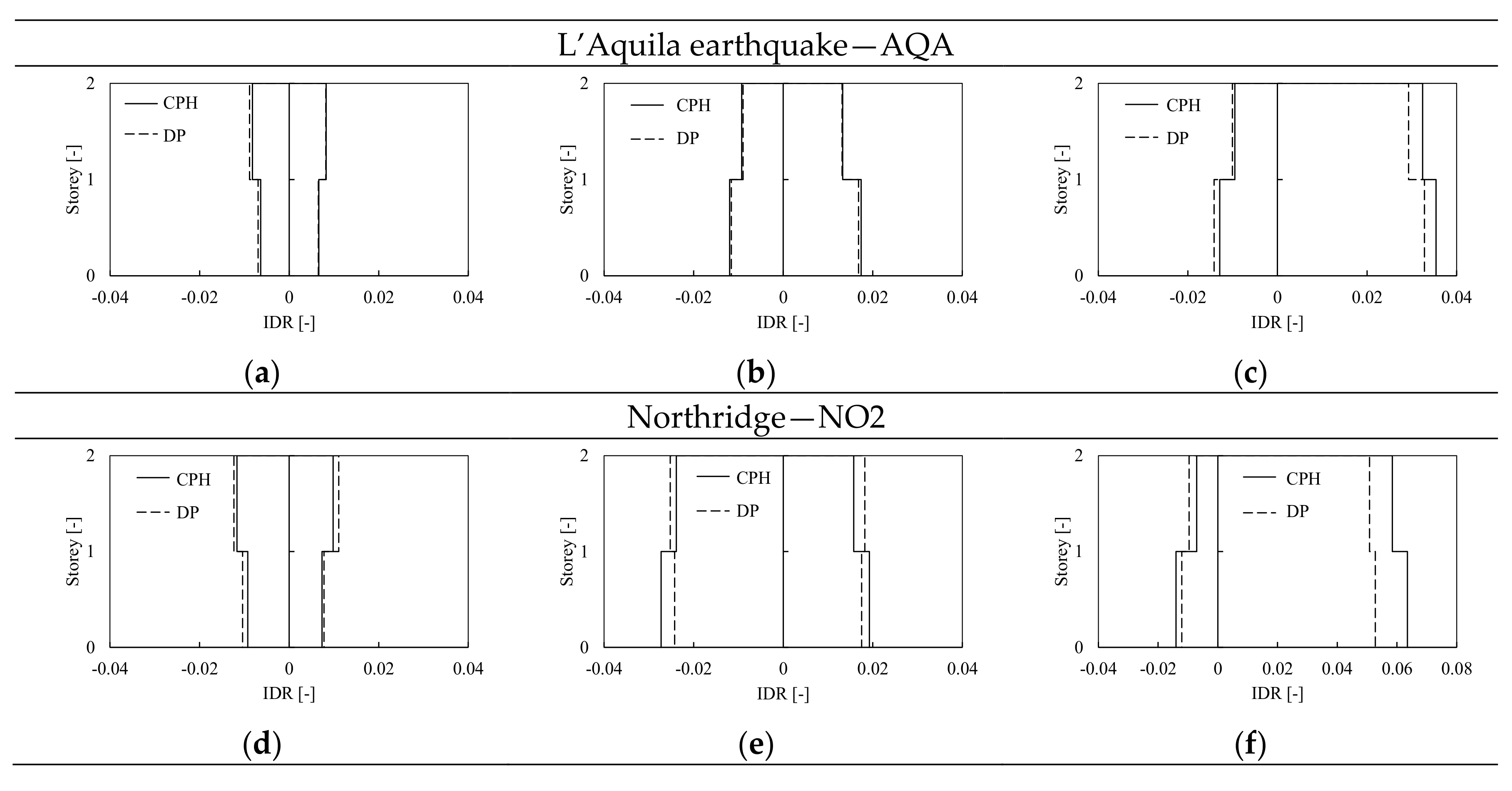
| Label | Type of Beam-to-Column Joint | Modeling Approach |
|---|---|---|
| H-CPH | Haunched joint (H) | Concentrated plastic hinge (CPH) |
| H-DP | Haunched joint (H) | Distributed plastic model (DP) |
| RBS-CPH | Reduced beam section (RBS) | Concentrated plastic hinge (CPH) |
| RBS-DP | Reduced beam section (RBS) | Distributed plastic model (DP) |
| ID | Site | Date | MS | h | Station | Peak Ground Acceleration | ||
|---|---|---|---|---|---|---|---|---|
| Long. | Trans. | Vert. | ||||||
| - | - | - | - | km | - | g | g | g |
| AQA | L’Aquila, Italy | 06/04/2009 | 6.3 | 8.8 | AQA | 0.44 | 0.40 | 0.47 |
| AQK | L’Aquila, Italy | 06/04/2009 | 6.3 | 8.8 | AQK | 0.35 | 0.33 | 0.37 |
| LO | Loma Pietra, USA | 18/10/1989 | 7.17 | 17 | COR | 0.47 | 0.64 | 0.43 |
| NO | Northridge, USA | 17/01/1994 | 6.7 | 12 | ST24436 | 1.78 | 0.99 | 1.05 |
| NO2 | Northridge, USA | 17/01/1994 | 6.7 | 12 | NFS | 0.59 | 0.58 | 0.55 |
| Haunched Joints | RBS Joints | ||||||
|---|---|---|---|---|---|---|---|
| ID | DL | SD | NC | DL | SD | NC | |
| - | % | % | % | % | % | % | |
| CPH | AQA | 0.032 | 0.307 | 1.475 | 0.009 | 0.154 | 0.848 |
| AQK | 0.015 | 0.032 | 0.013 | 0.009 | 0.001 | 0.151 | |
| LO | 0.01 | 0.135 | 0.581 | 0.003 | 0.087 | 0.524 | |
| NO | 0.013 | 0.067 | 0.262 | 0.041 | 0.080 | 0.367 | |
| NO2 | 0.011 | 0.075 | 0.858 | 0.034 | 1.223 | 1.012 | |
| DP | AQA | 0.031 | 0.316 | 1.424 | 0.008 | 0.149 | 0.806 |
| AQK | 0.015 | 0.031 | 0.012 | 0.009 | 0.001 | 0.140 | |
| LO | 0.010 | 0.131 | 0.576 | 0.003 | 0.083 | 0.478 | |
| NO | 0.013 | 0.066 | 0.273 | 0.040 | 0.076 | 0.329 | |
| NO2 | 0.011 | 0.074 | 0.836 | 0.033 | 1.174 | 0.921 | |
Publisher’s Note: MDPI stays neutral with regard to jurisdictional claims in published maps and institutional affiliations. |
© 2020 by the authors. Licensee MDPI, Basel, Switzerland. This article is an open access article distributed under the terms and conditions of the Creative Commons Attribution (CC BY) license (http://creativecommons.org/licenses/by/4.0/).
Share and Cite
Tartaglia, R.; D’Aniello, M.; Landolfo, R. Numerical Simulations to Predict the Seismic Performance of a 2-Story Steel Moment-Resisting Frame. Materials 2020, 13, 4831. https://doi.org/10.3390/ma13214831
Tartaglia R, D’Aniello M, Landolfo R. Numerical Simulations to Predict the Seismic Performance of a 2-Story Steel Moment-Resisting Frame. Materials. 2020; 13(21):4831. https://doi.org/10.3390/ma13214831
Chicago/Turabian StyleTartaglia, Roberto, Mario D’Aniello, and Raffaele Landolfo. 2020. "Numerical Simulations to Predict the Seismic Performance of a 2-Story Steel Moment-Resisting Frame" Materials 13, no. 21: 4831. https://doi.org/10.3390/ma13214831
APA StyleTartaglia, R., D’Aniello, M., & Landolfo, R. (2020). Numerical Simulations to Predict the Seismic Performance of a 2-Story Steel Moment-Resisting Frame. Materials, 13(21), 4831. https://doi.org/10.3390/ma13214831







